2014 Corvette Stingray Complete Detail with Clear Bra and Vinyl Wrap Install: Part 2 of 2
by Jean-Claude CorcoranIn part 1 we got a good sense of the condition of the Stingray as it arrived. We reviewed the removal and coating of the wheels and calipers, carbon fiber inserts/accents and a very thorough breakdown on how we made the tail lights look better than new.
Welcome to part 2. We will show the true condition and restoration of the paint, paint protection film/clear bra installation and the finished product with cQuartz Finest on the paint and Opti-Guard Leather and Fabric coating applied.
We measured the composite panel finishes with our Defelsko Positector 200 b3 Advanced. Paint work had approximately 26-31 microns of clear coat. Well within a safe range to work with.
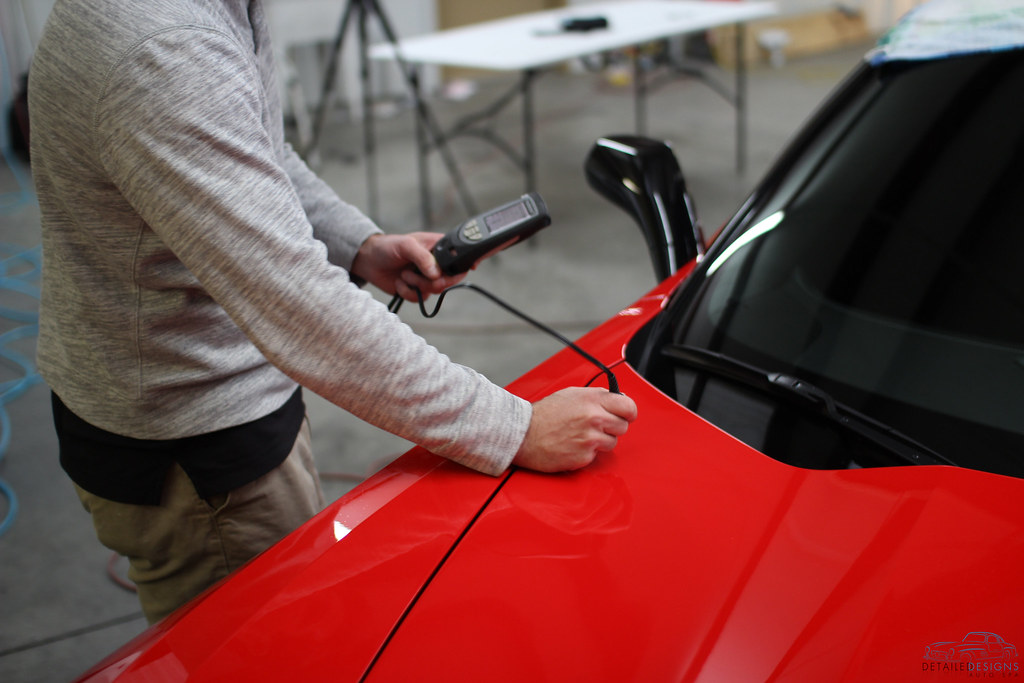
Preparing a surface for restoration is far too underrated in my opinion. Properly taping off sensitive areas will do a few things.
- Obviously, it helps to protect a surface from the mechanical abrasion of the pad and machine. My approach is to tape off an area and treat it as a back up in case you overshoot the panel you’re working on. It should not be used as a crutch to lean on. Even the best taping job could peel up in a spot. Better safe than sorry.
- It allows you to more thoroughly work a panel. When we are restoring paint, our goal is to restore the edge of a panel as much as the middle of the panel. Taping off nearby panels and surfaces allows someone to focus on one edge, the important one…the one you’re working on. By nature, working an edge or a high point on a panel tends to be a hot spot, or rather, an area prone to excessive heat while correcting. Taping off the edge of a nearby panel gives you one less area to be overly concerned with while working towards those more demanding results.
I think it’s worth noting that thorough taping takes a long time. Which translates to a higher cost on a project. If you are doing this for yourself, understand that there is an art to taping and you can waste a ton of it to get the right protection without being sloppy and taping too much over the painted surfaces. I’ve seen detailers take as long as possible and still not do a great job. Be patient while learning how to do this step, it will pay off.
We aren’t joking when we talk about protecting surfaces.
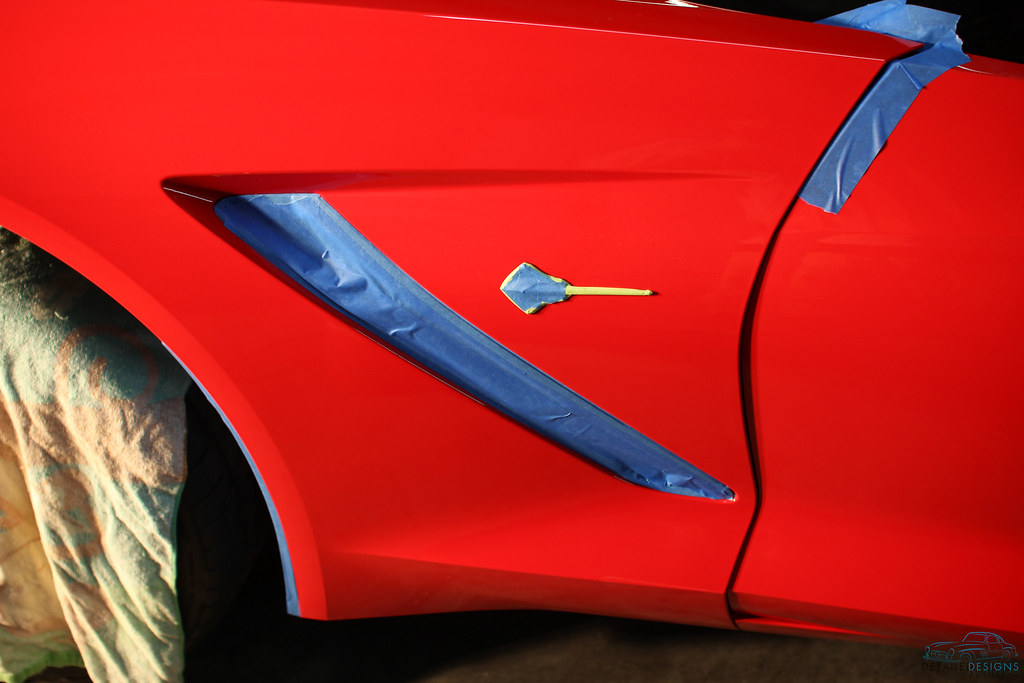
The hood had already been restored in this image. We were moving towards getting results on the fenders here. Generally, bumpers are done last on our projects.
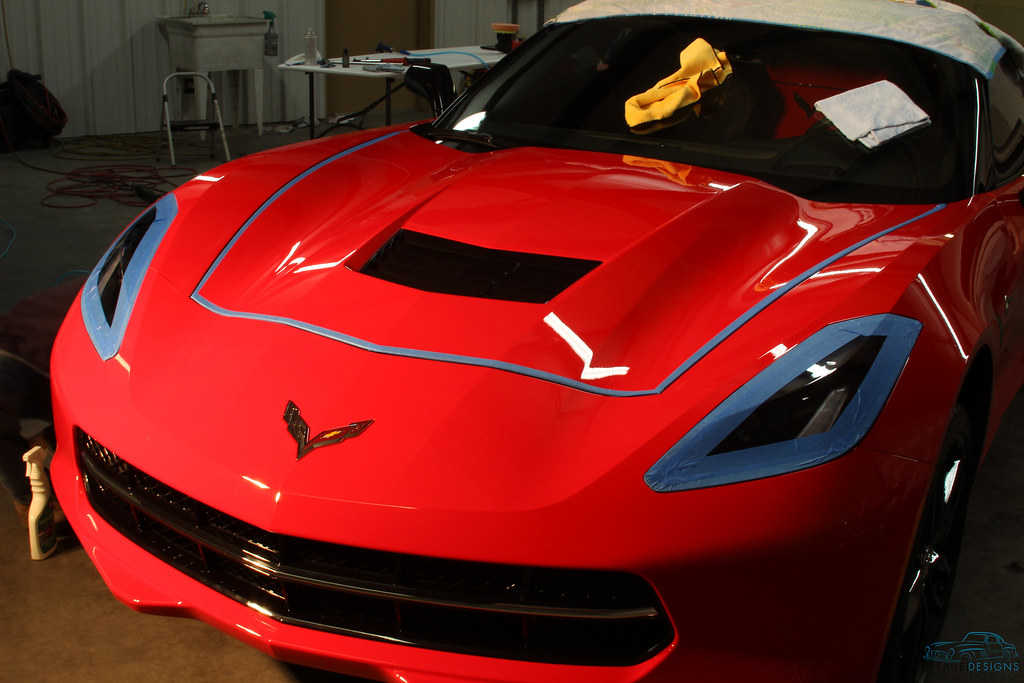
The paint was far from new looking despite the Stingray’s age. Deep scratches, swirl marks and factory DA sanding marks were all present on this brand new car that had never seen a hand or machine wash outside of the factory or dealership. Our silver level paint correct was still able to take make a huge impact in the paint’s appearance.
One of the many examples of deep damage we found and repaired. You will probably notice the lack of swirl marks around the heavy scratch. This picture was taken after our initial cut phase but before we did spot heavy scratch removal.
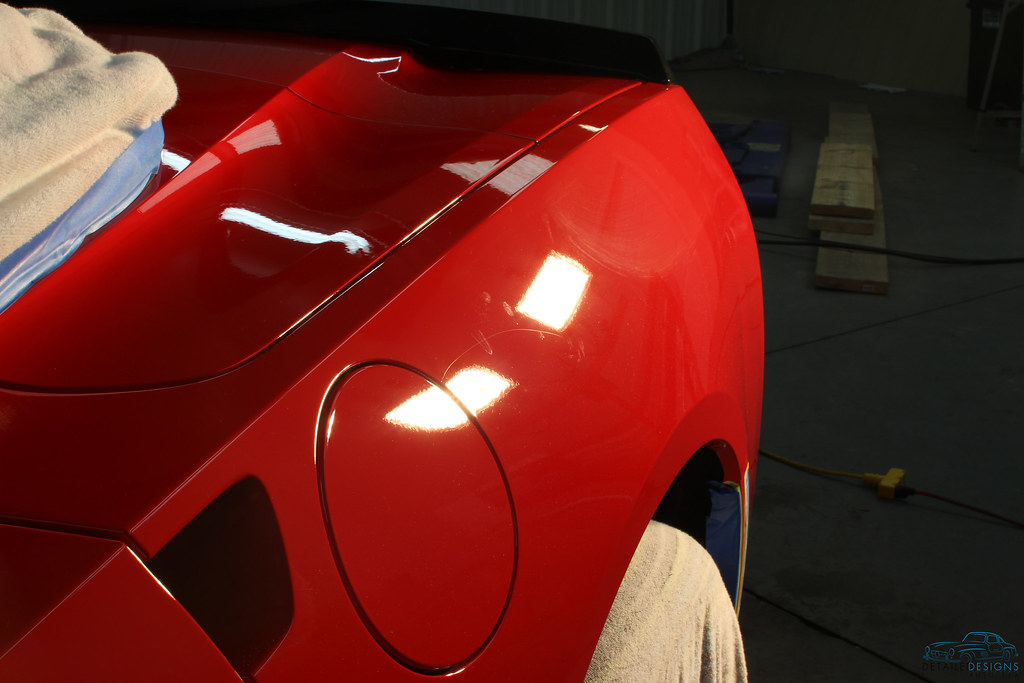
After
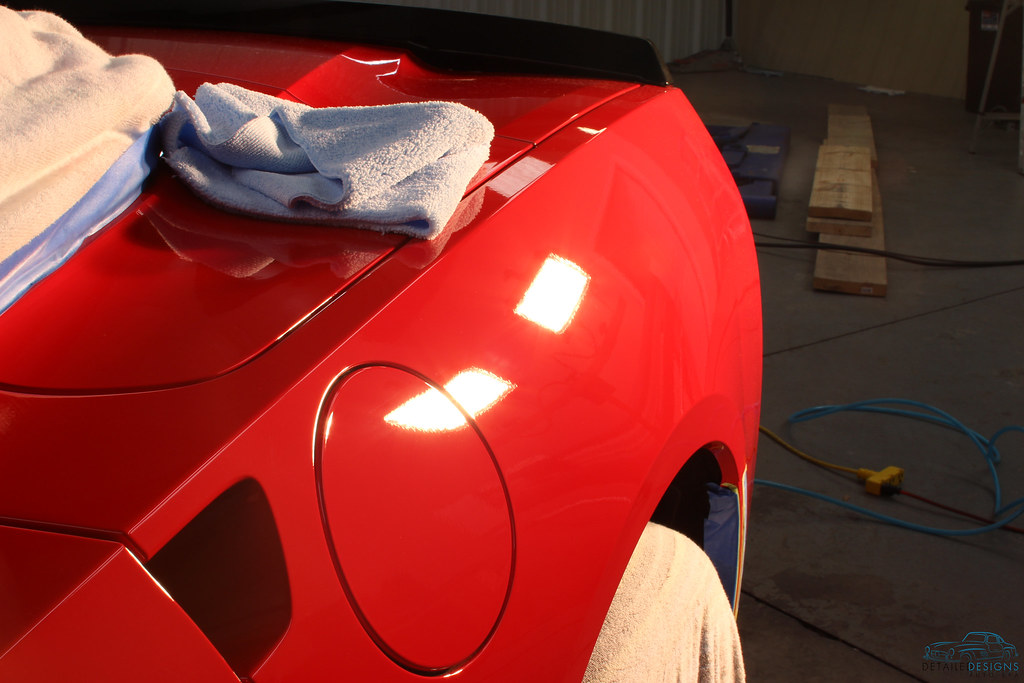
Rear diffuser before correction
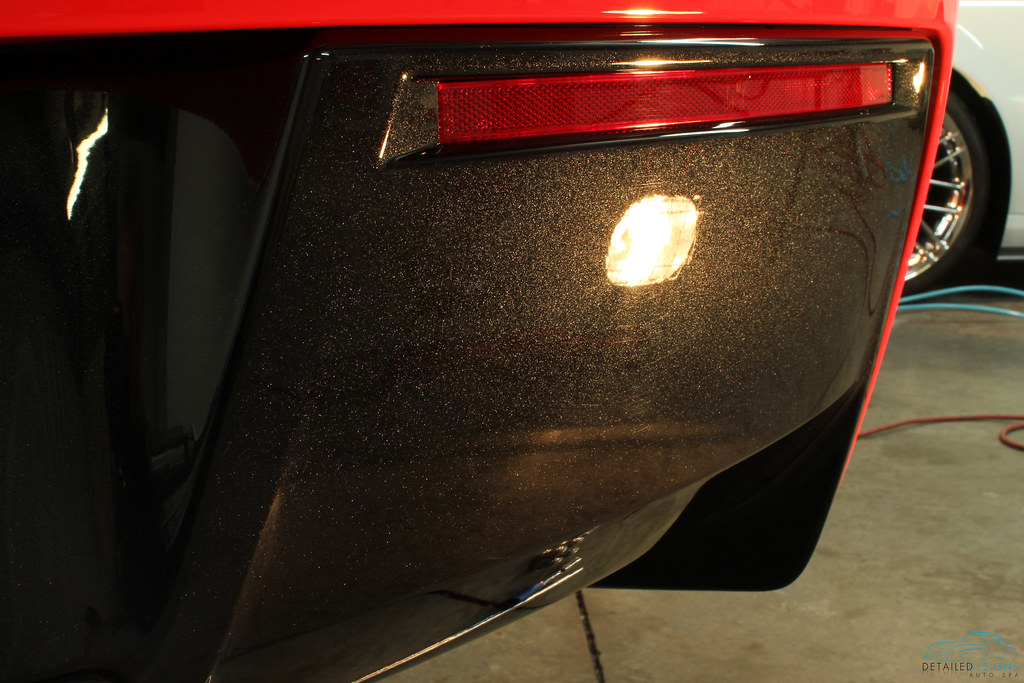
After
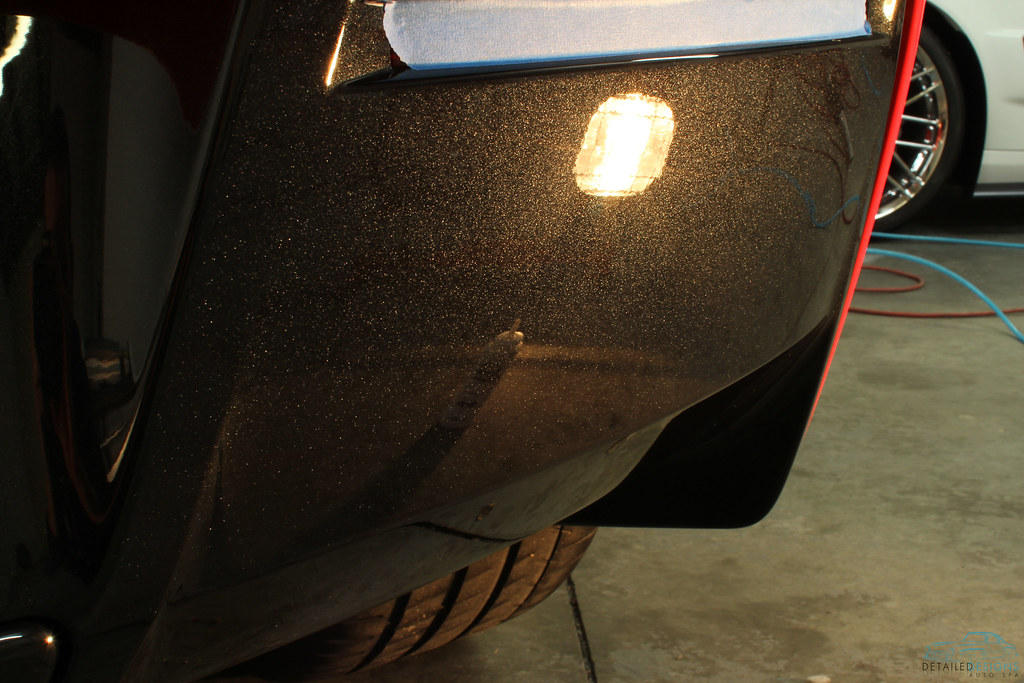
Rear spoiler before

After
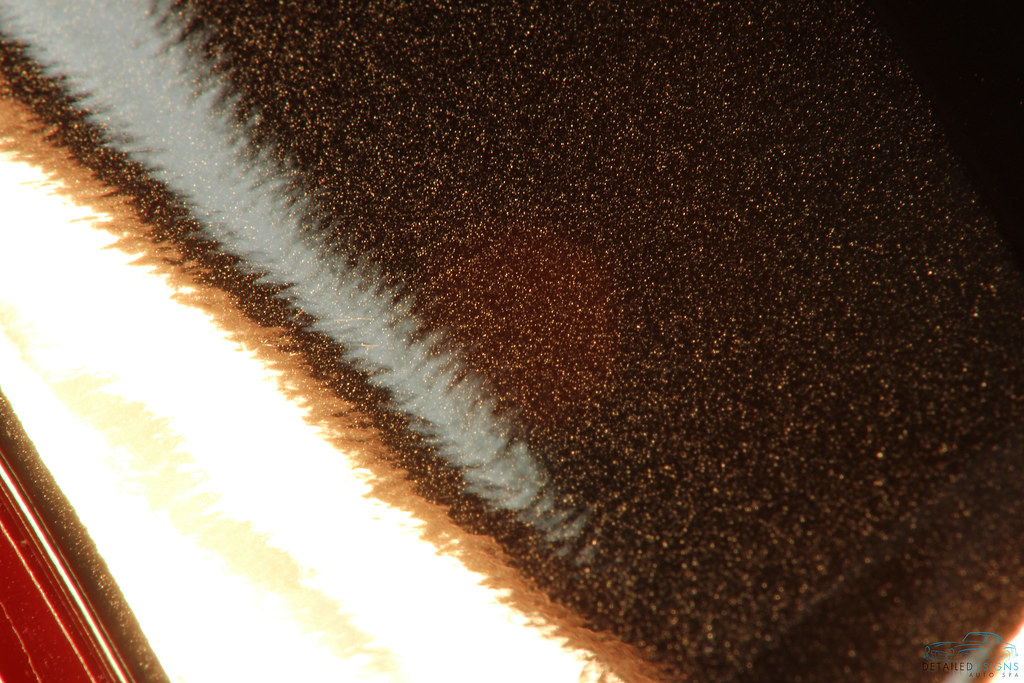

Rear side of rear spoiler before
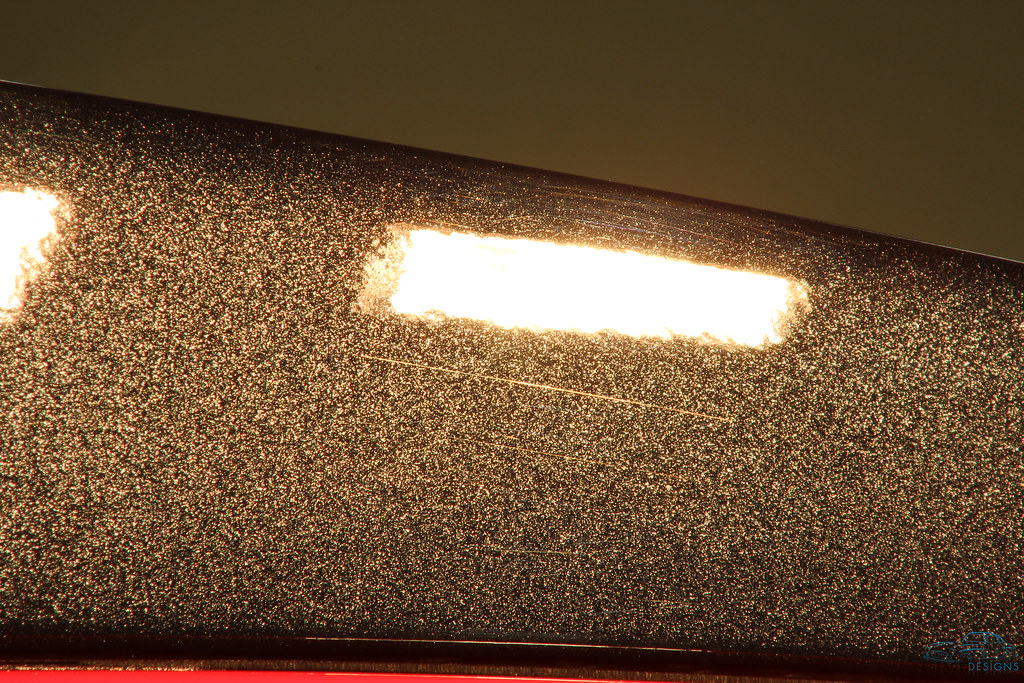
After
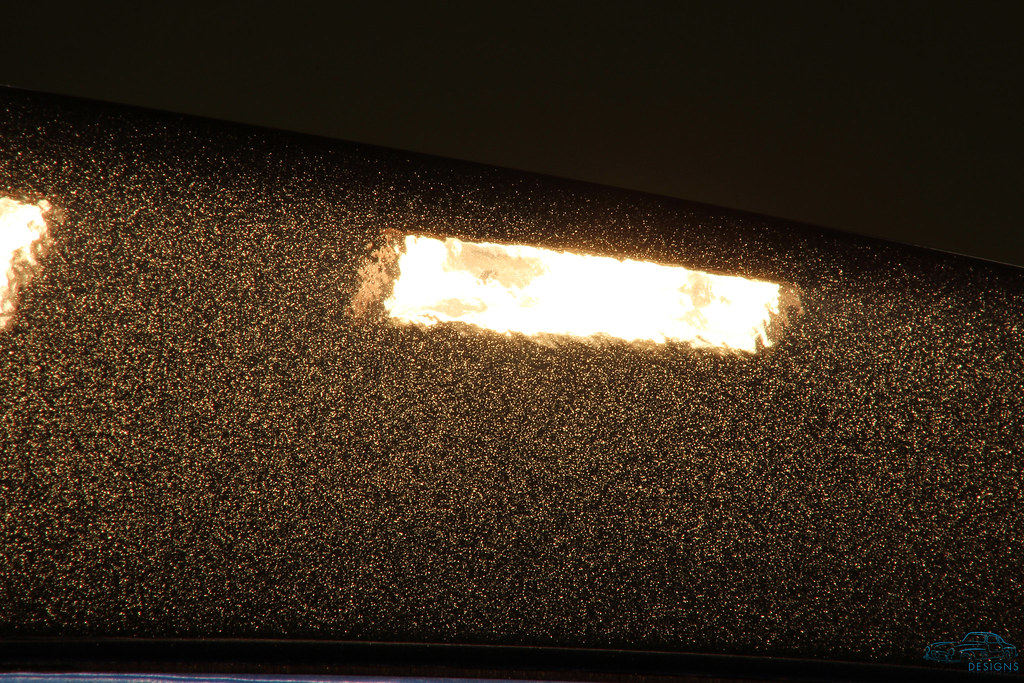
Gnarly deck lid damage

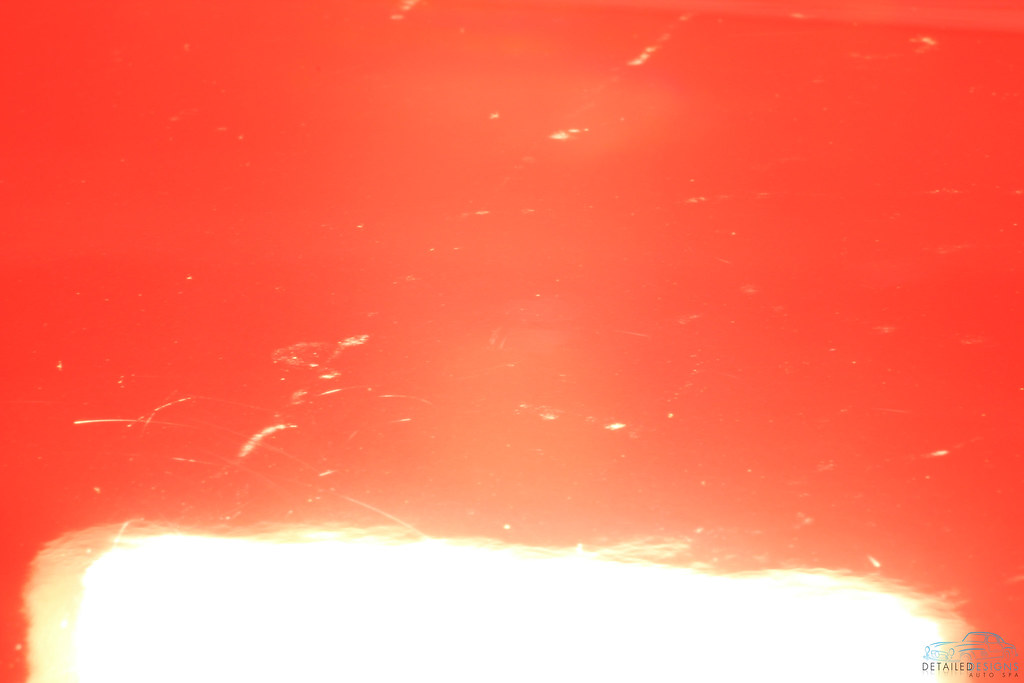
Beautiful
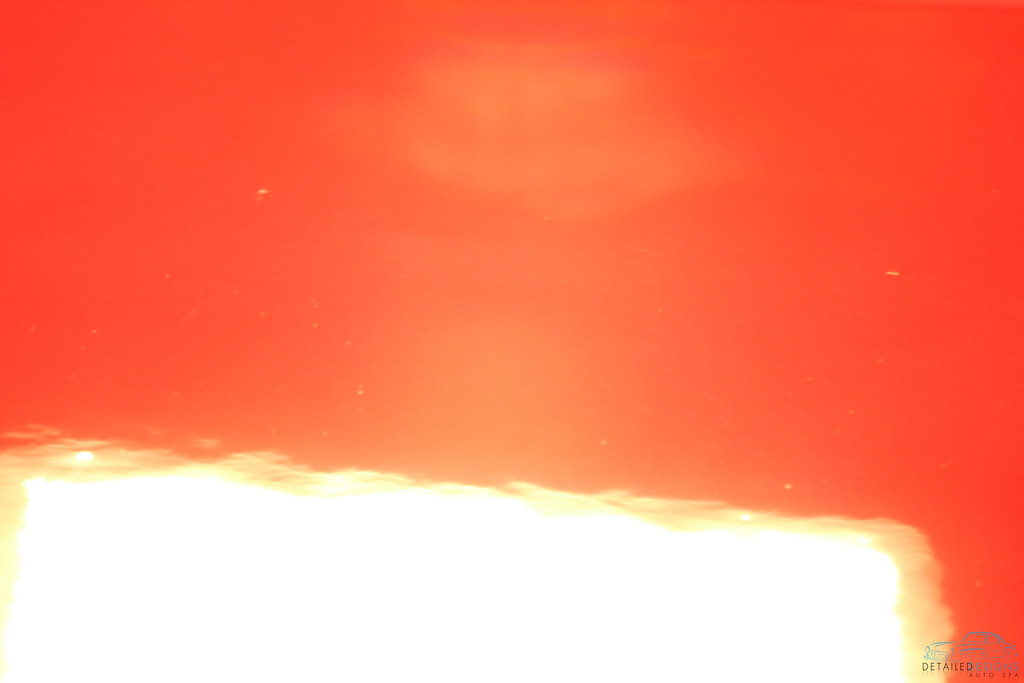

Another before

After
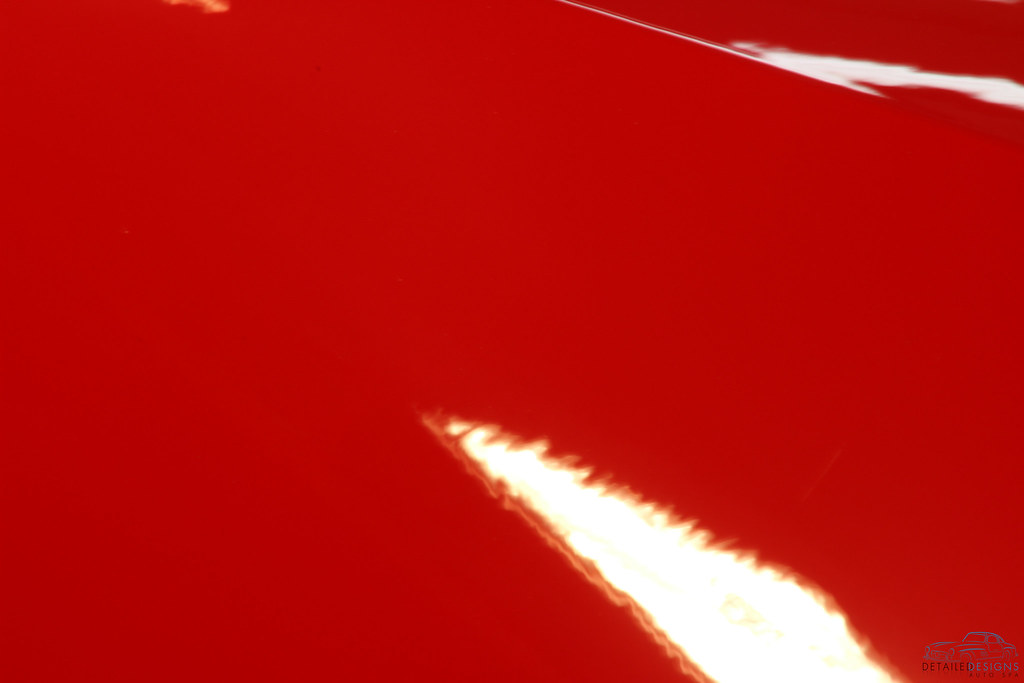
Getting after it with a Flex 3401

Sure, we are going to install clear bra and carbon fiber vinyl film on the front end of the car. But not cleaning up the paint prior to protecting it is not an option! Looks like she’s ready for paint protection film and carbon fiber vinyl film.
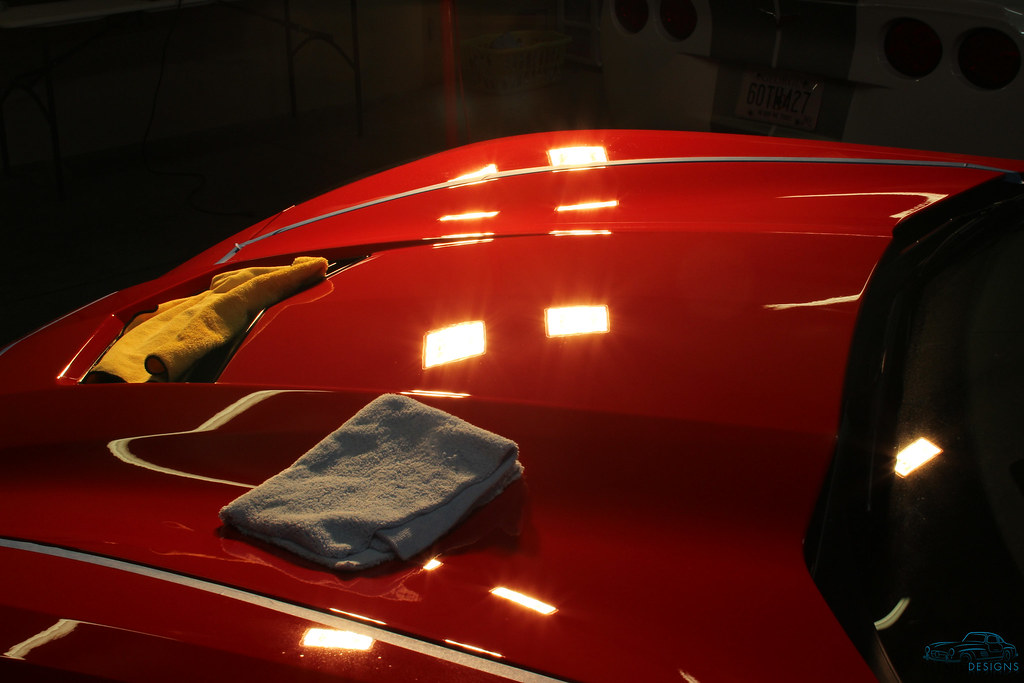
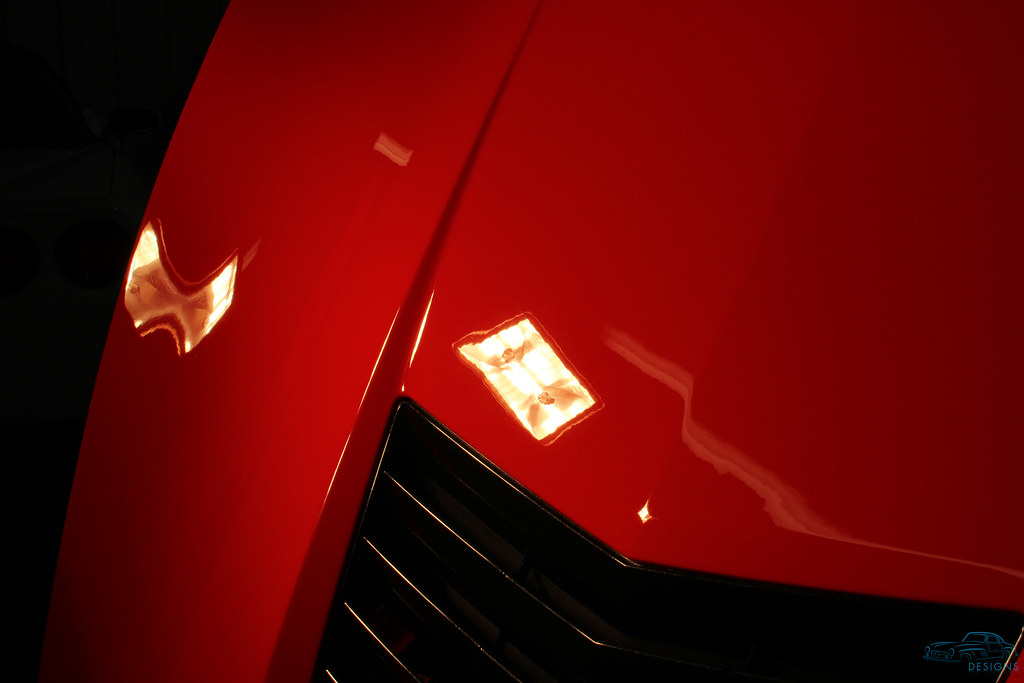
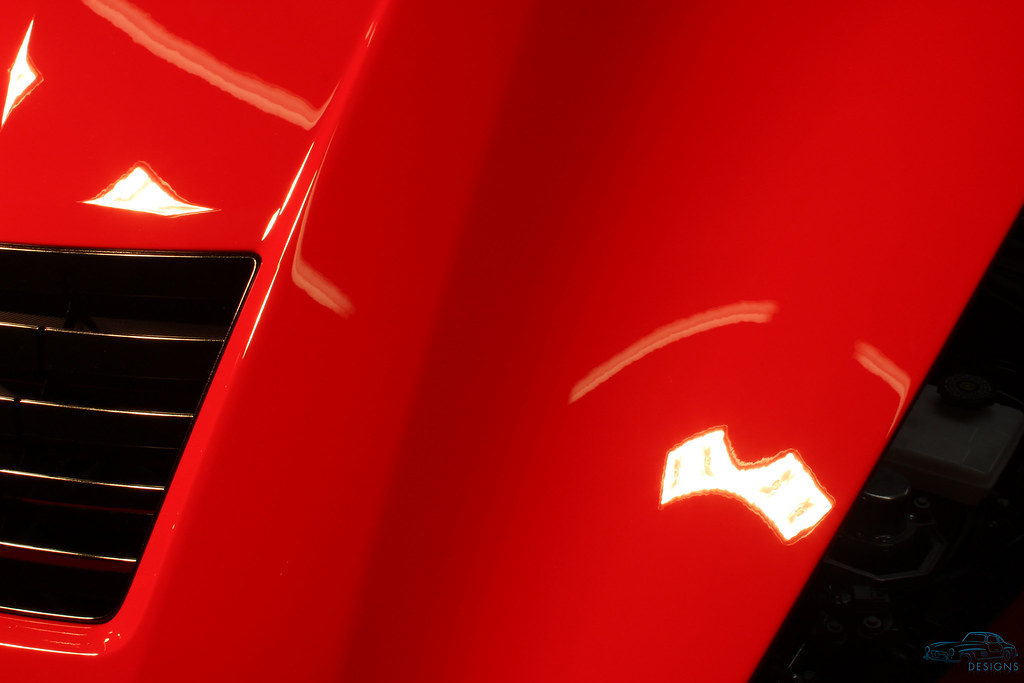
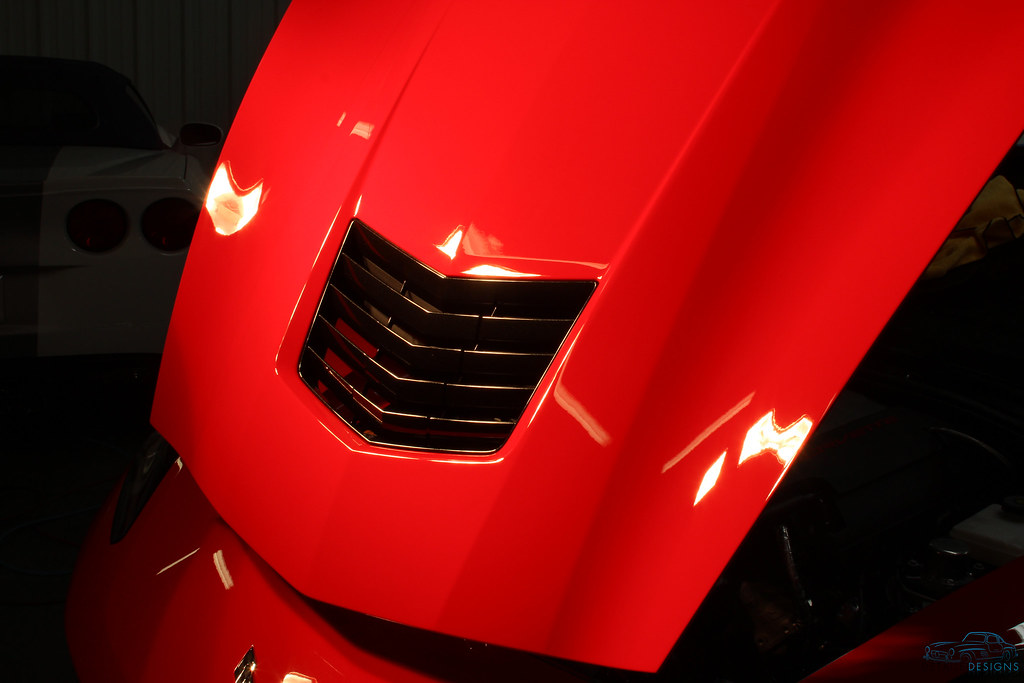
Carbon fiber vinyl is installed. Here I am installing the full hood clear bra piece. We use wide format plotters to cut precision patterns designed for the exact panel we are protecting. The Stingray had clear bra installed on the whole hood, whole front fenders, front bumper, side mirrors, a-pillars, door cups, rocker panels and a strip on the trunk lid. The owner was so happy with how it came out that he wants to come back to have the rest of the car protected with clear bra in a month or so.
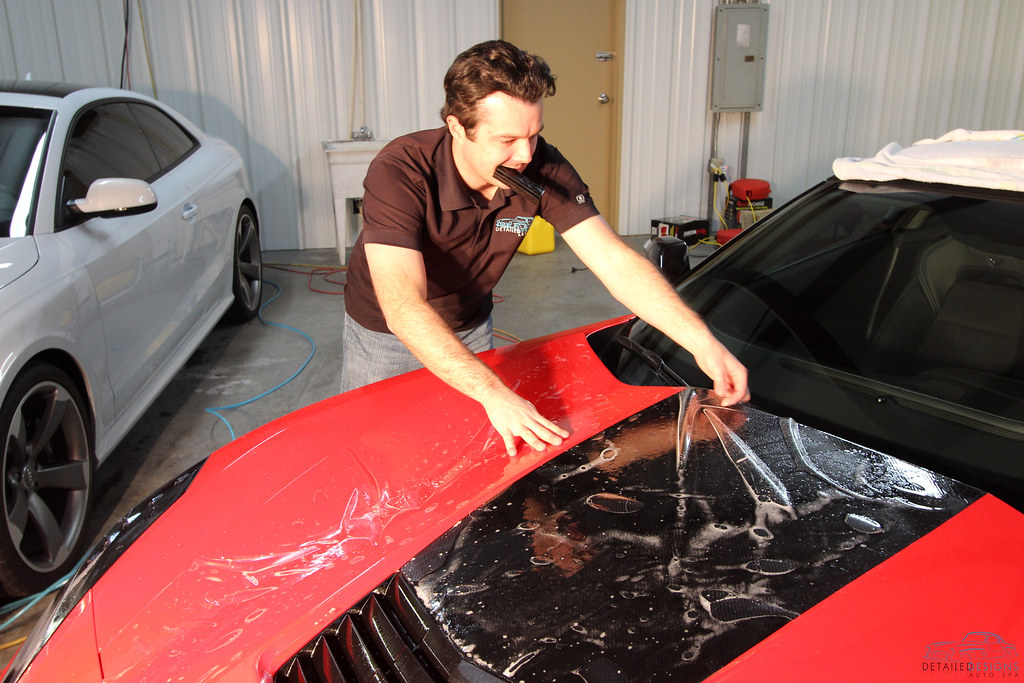
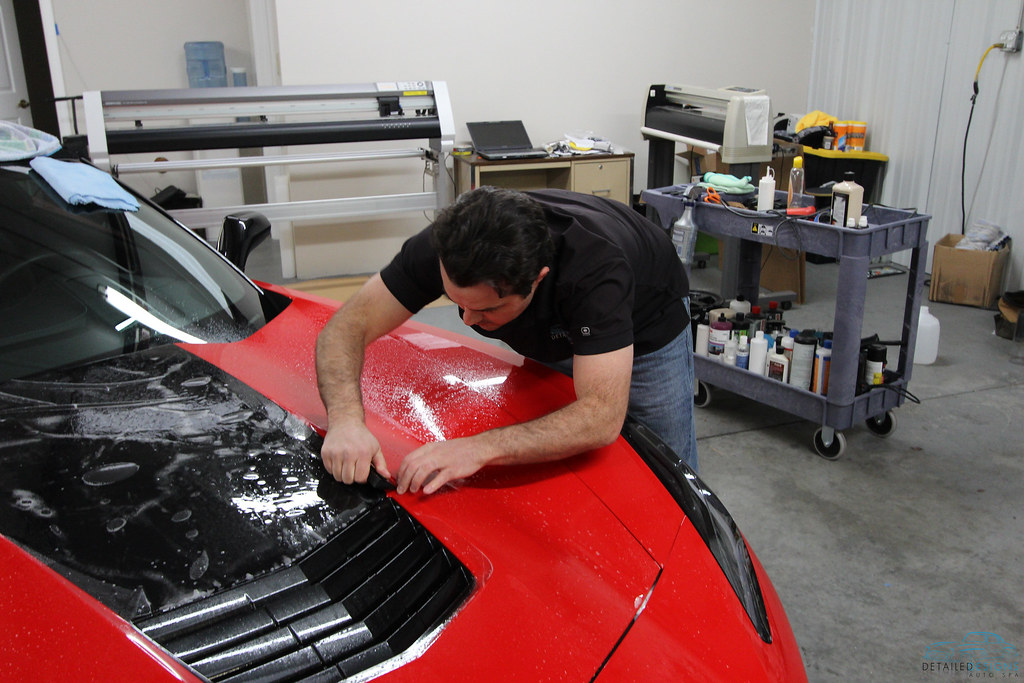
After all of the detailing and restoration for the exterior we topped it off with 2 coats of cQuartz Finest. Our final product was exactly what the client was looking for. The automobile was cleaned, decontaminated, restored and protected. The interior was thoroughly detailed. The seats were protected with Opti-Guard Leather and Fabric coating. Finally all of the exterior glass was treated with a long term water repellant coating.
Do you like finished detail shots? How about shots showing off the project in three different types of lighting? We have that.

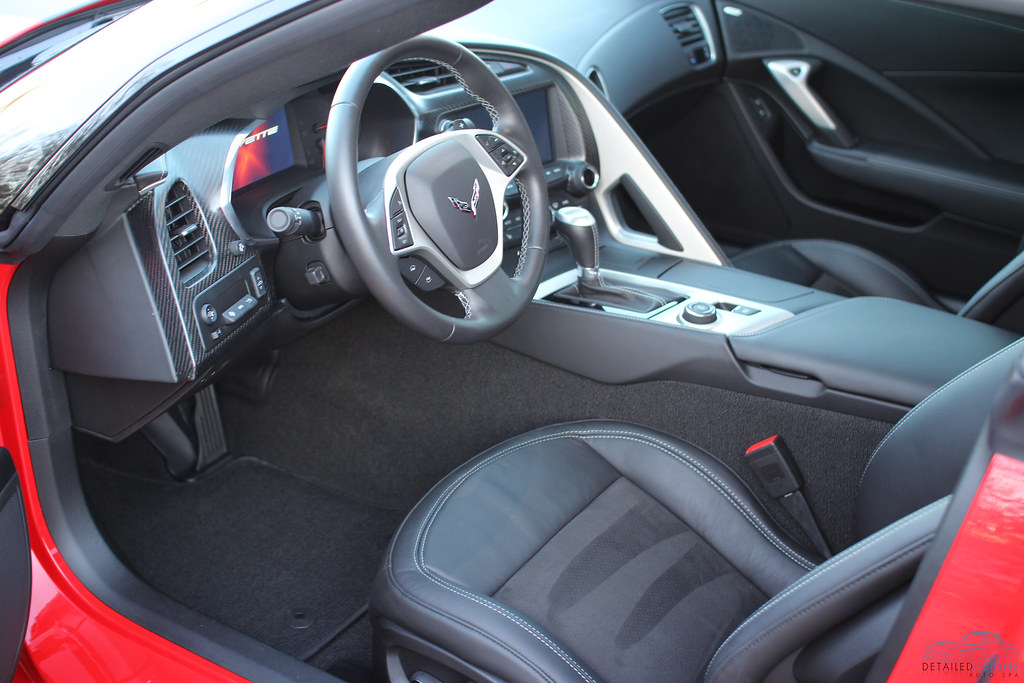
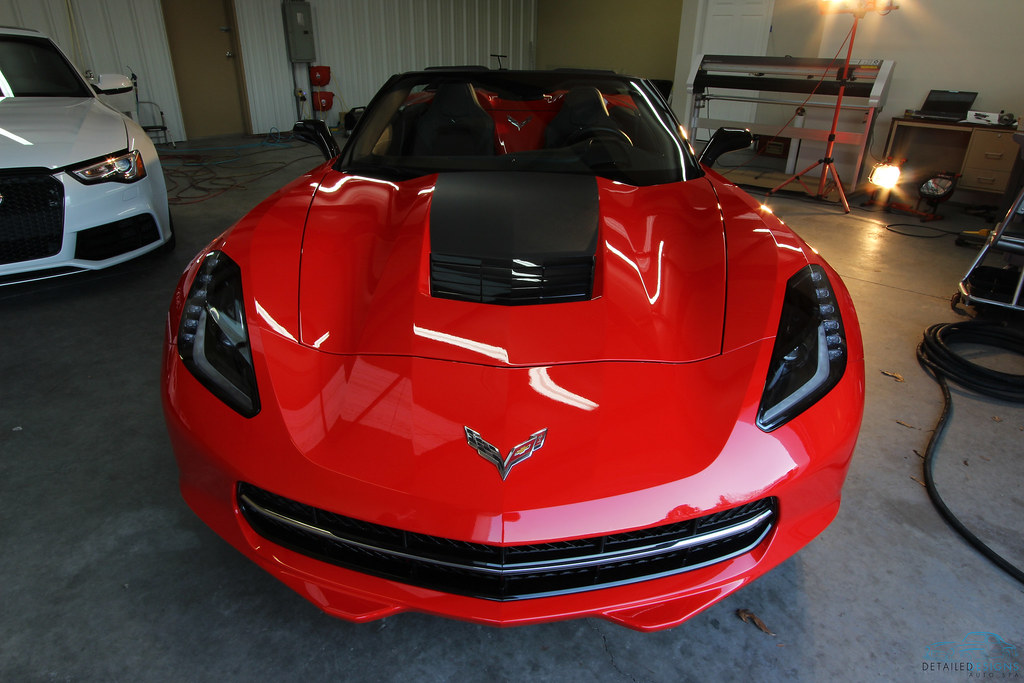
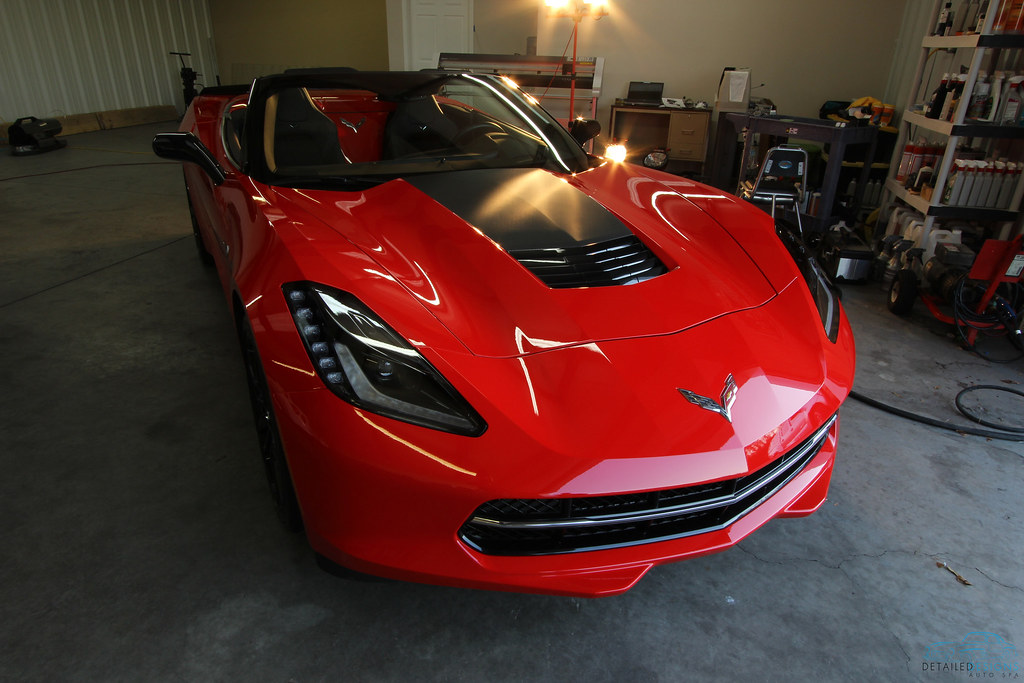
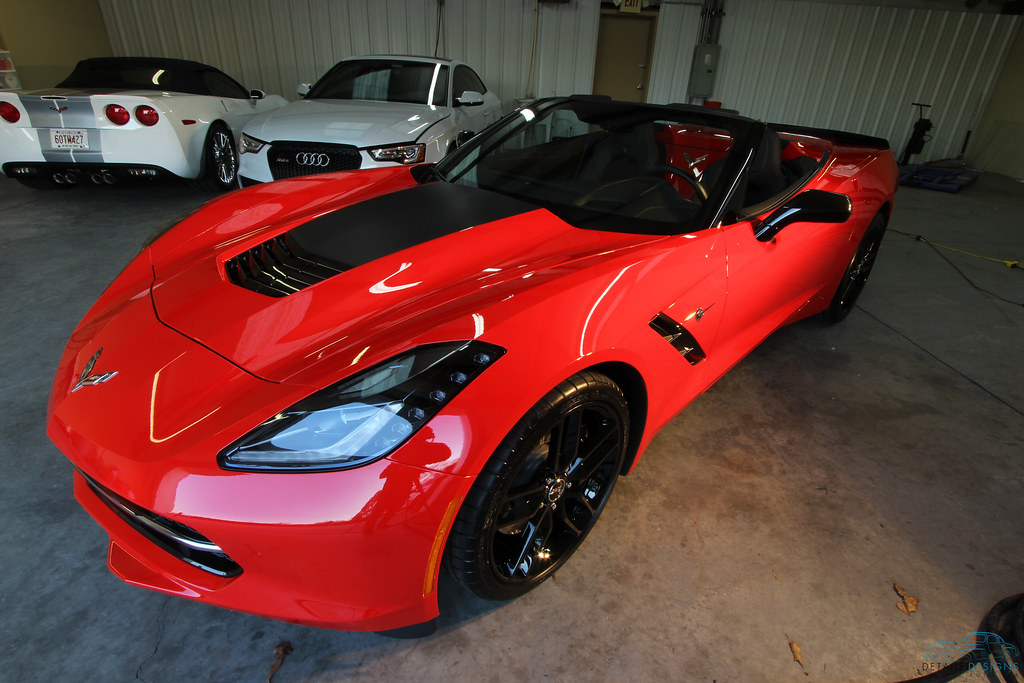
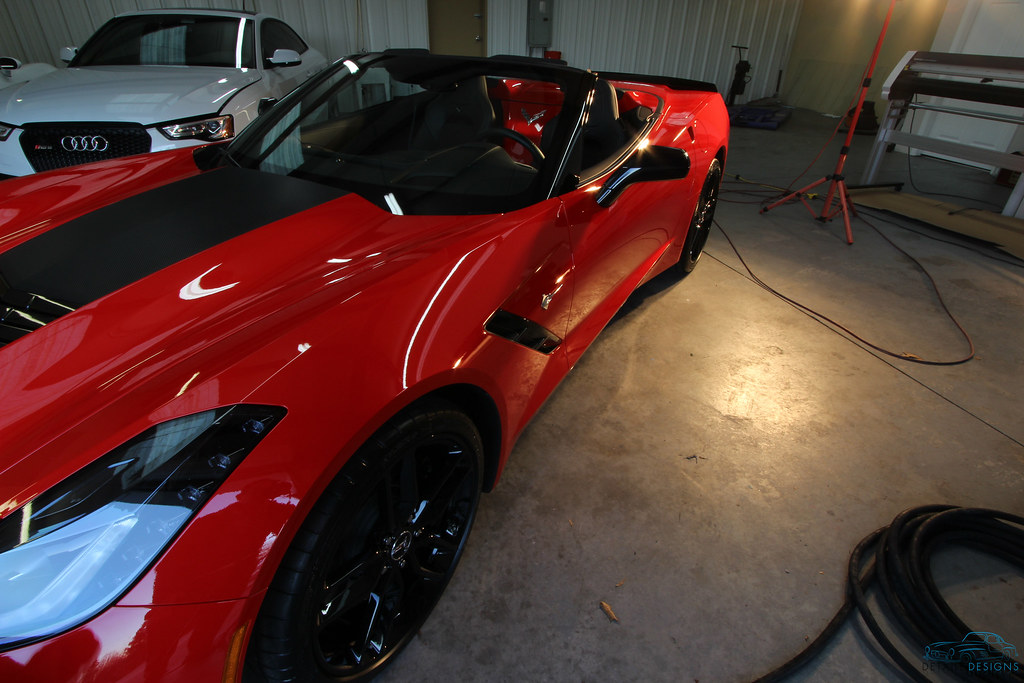
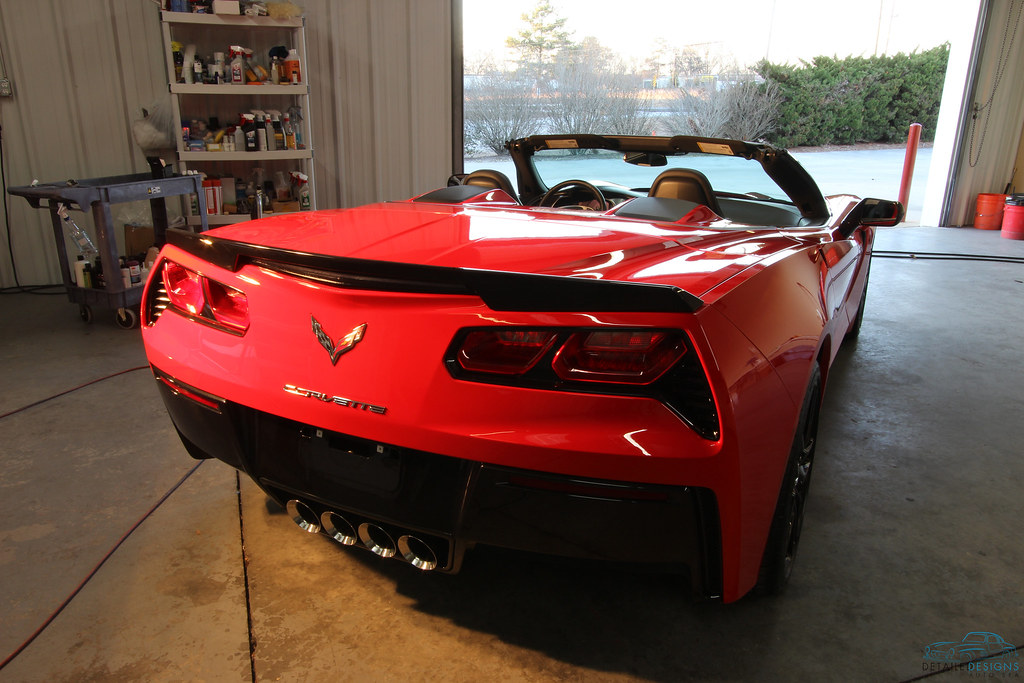
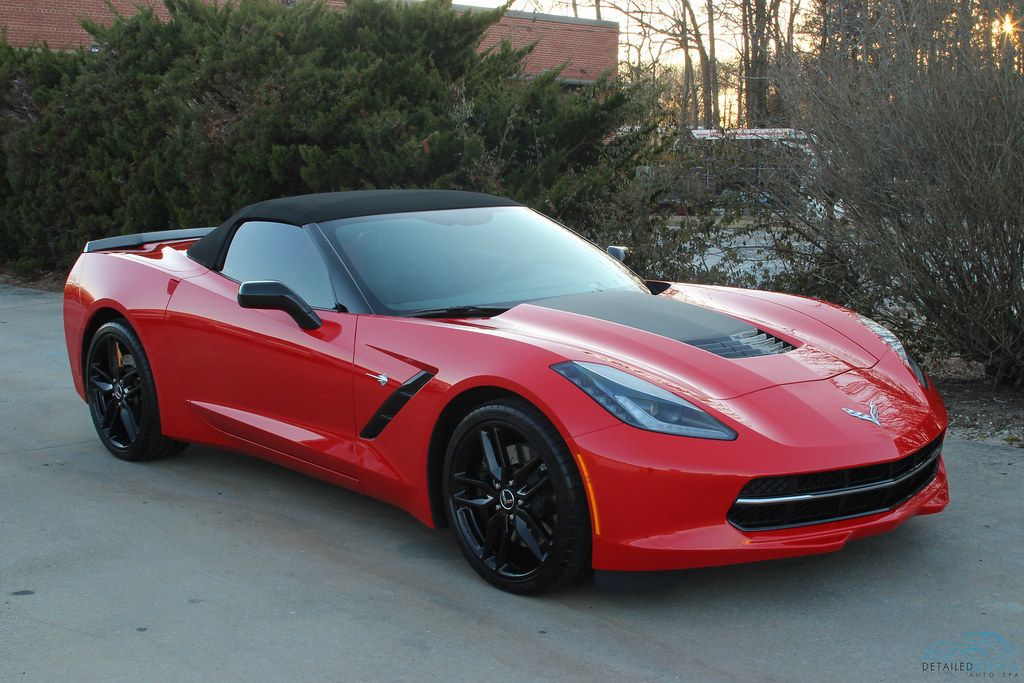
Remember those hammered wheels?

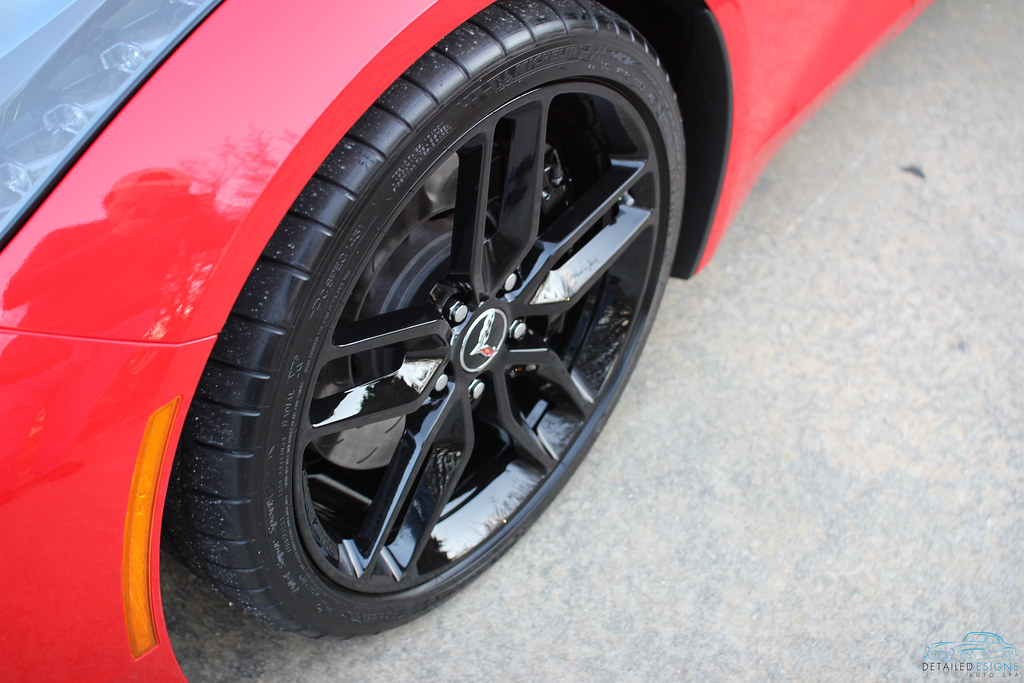
Tail pipes are spot on!
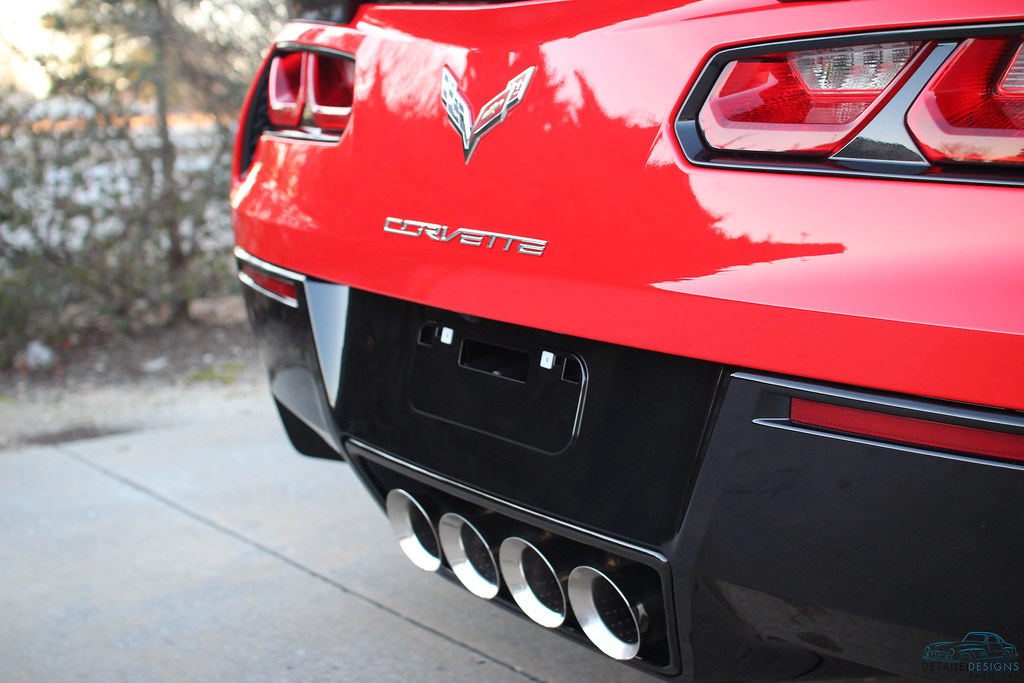
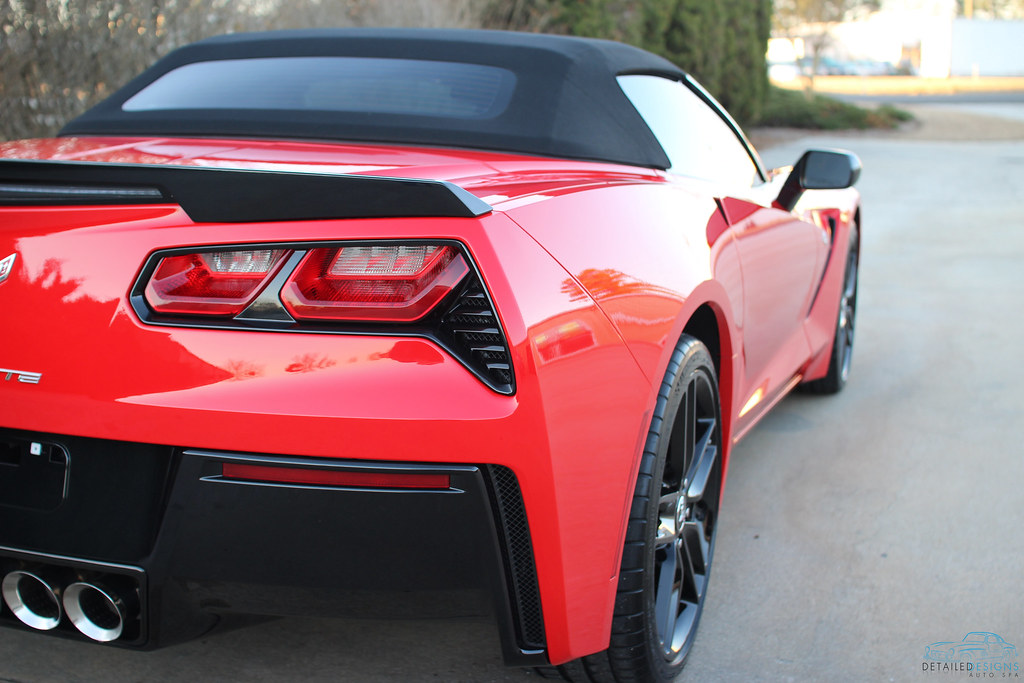
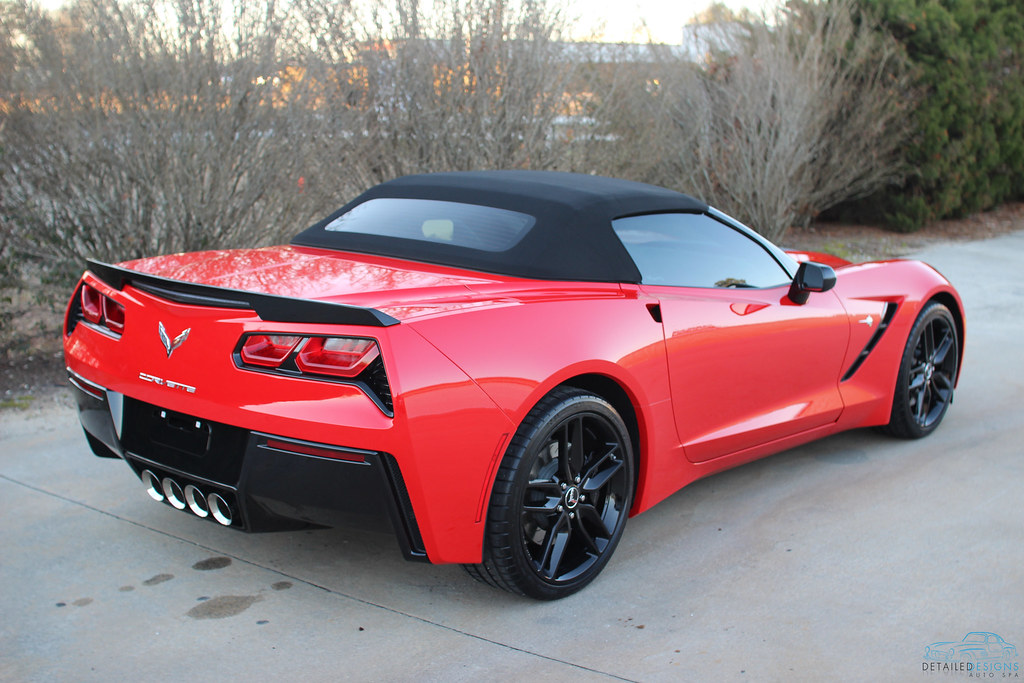
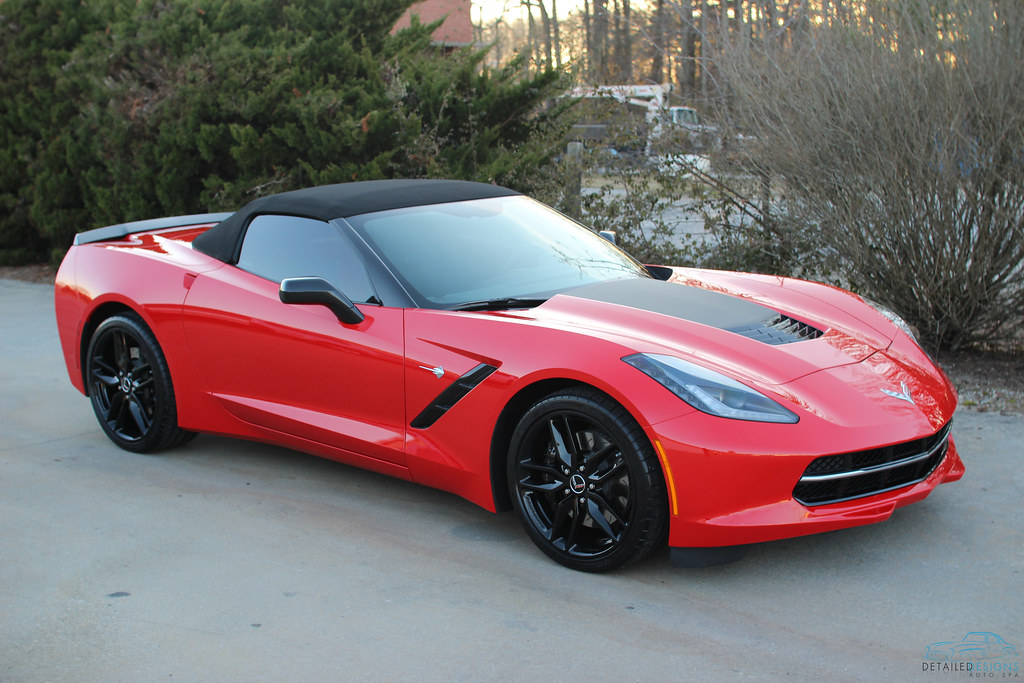


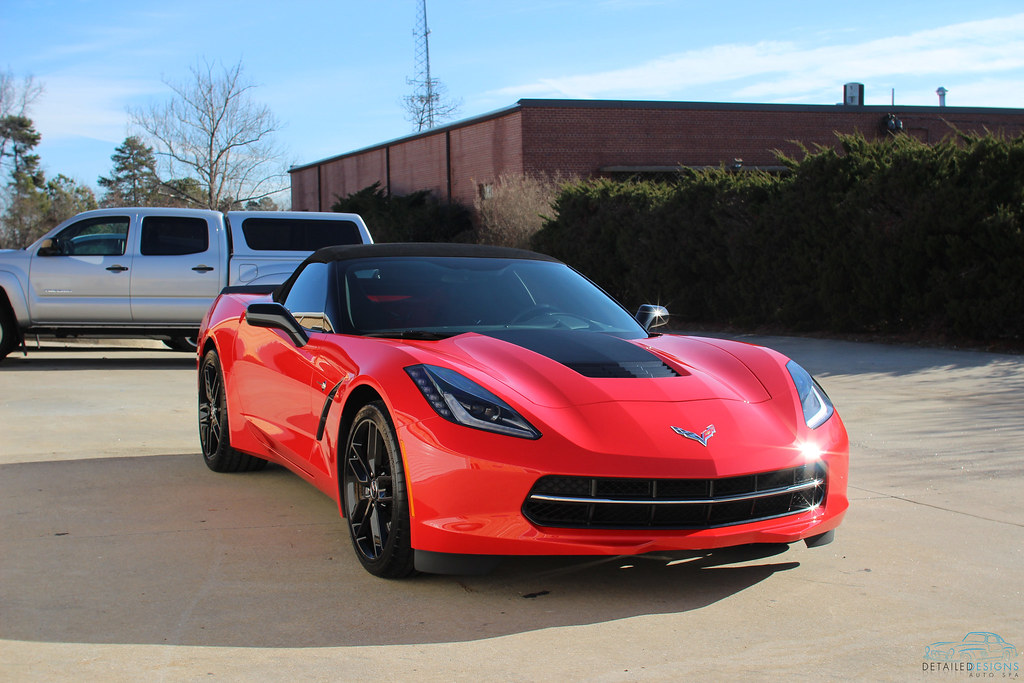
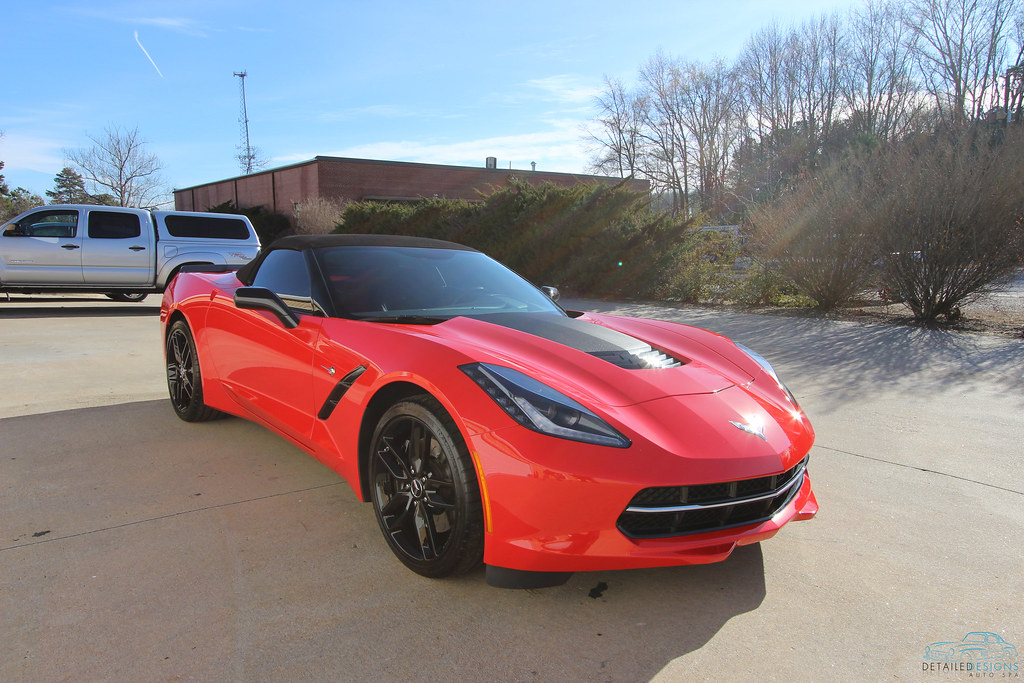
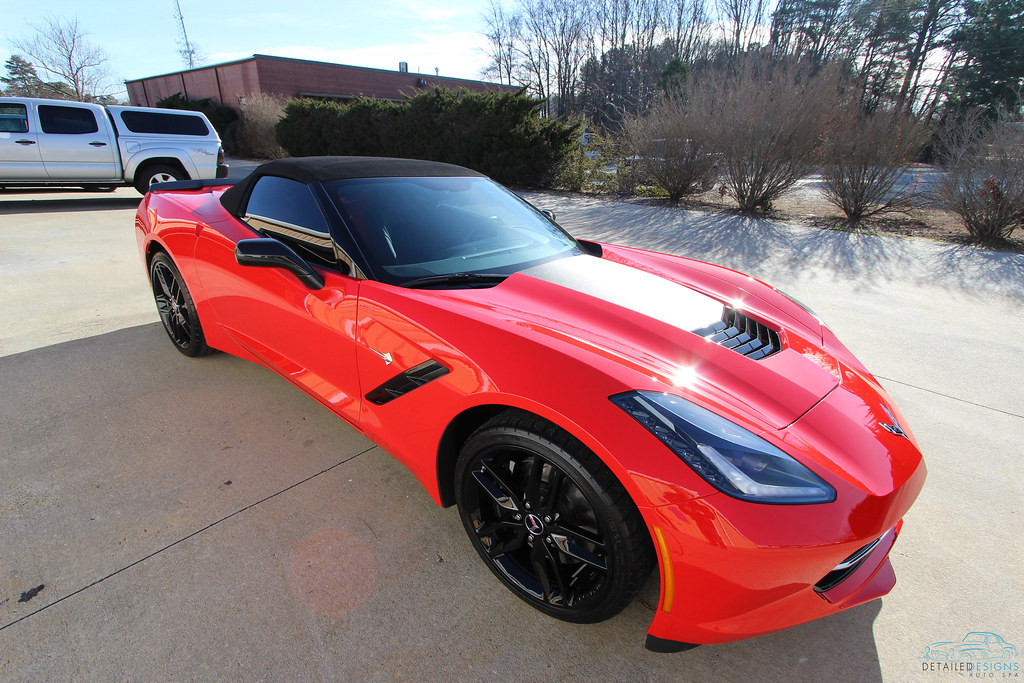
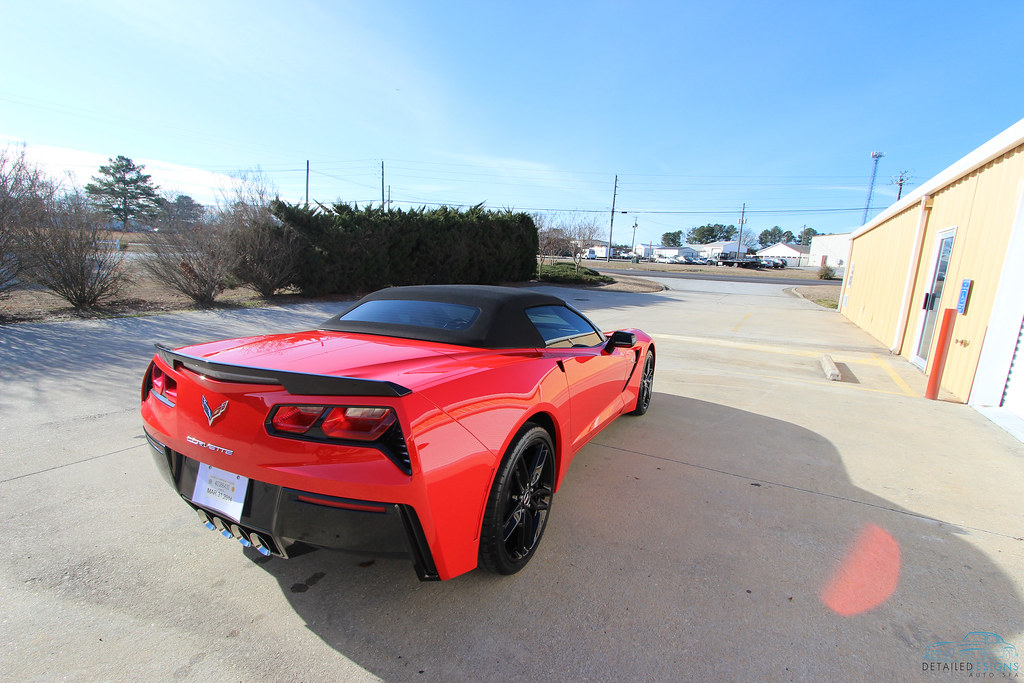
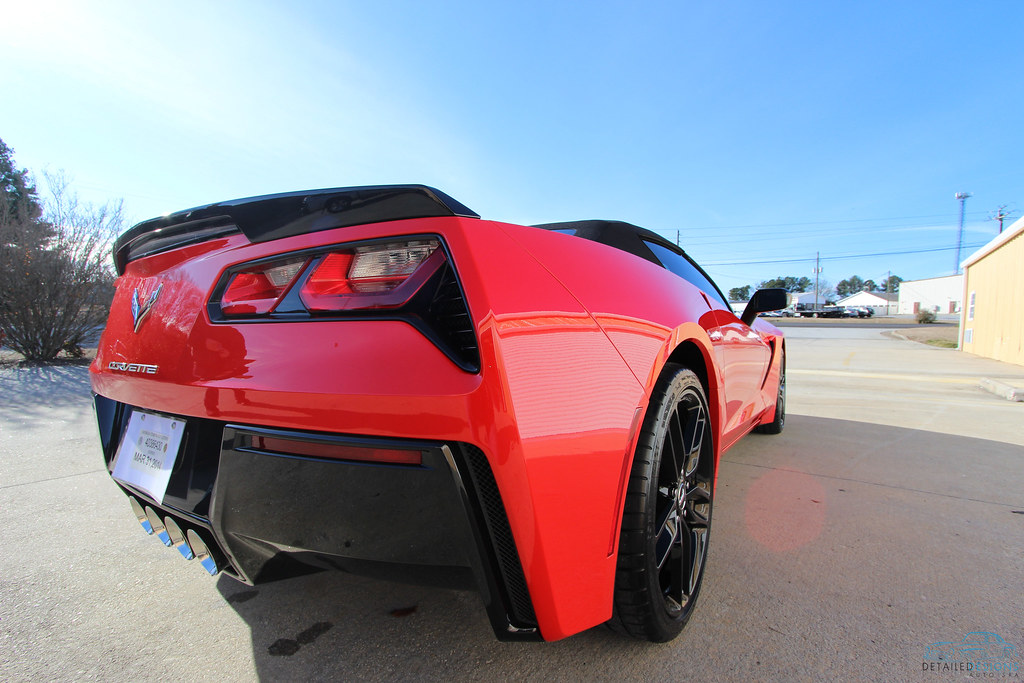
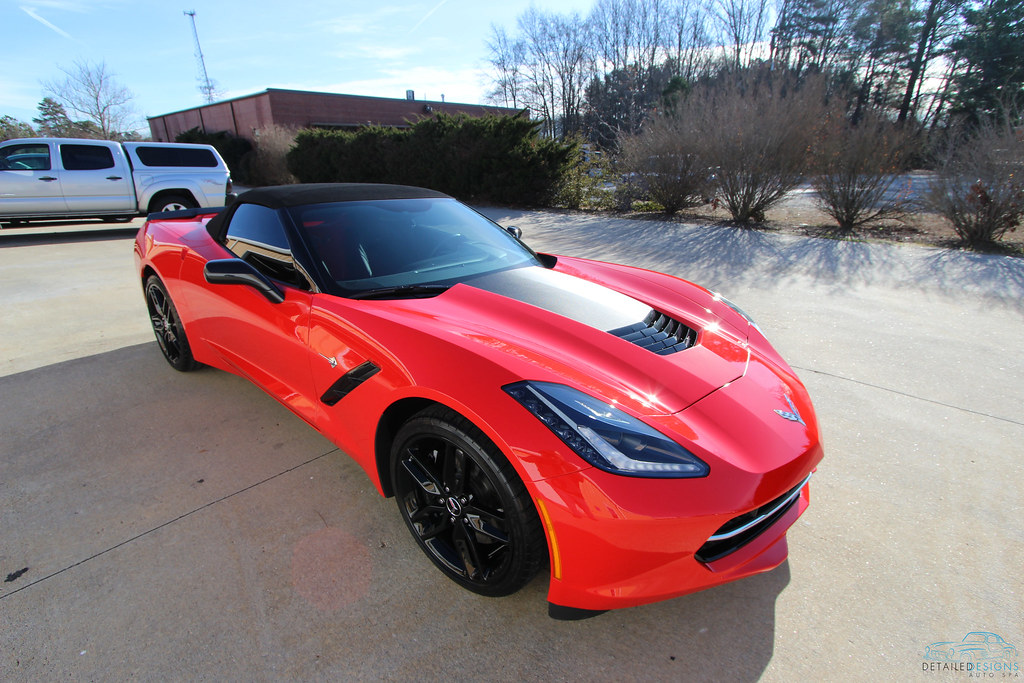
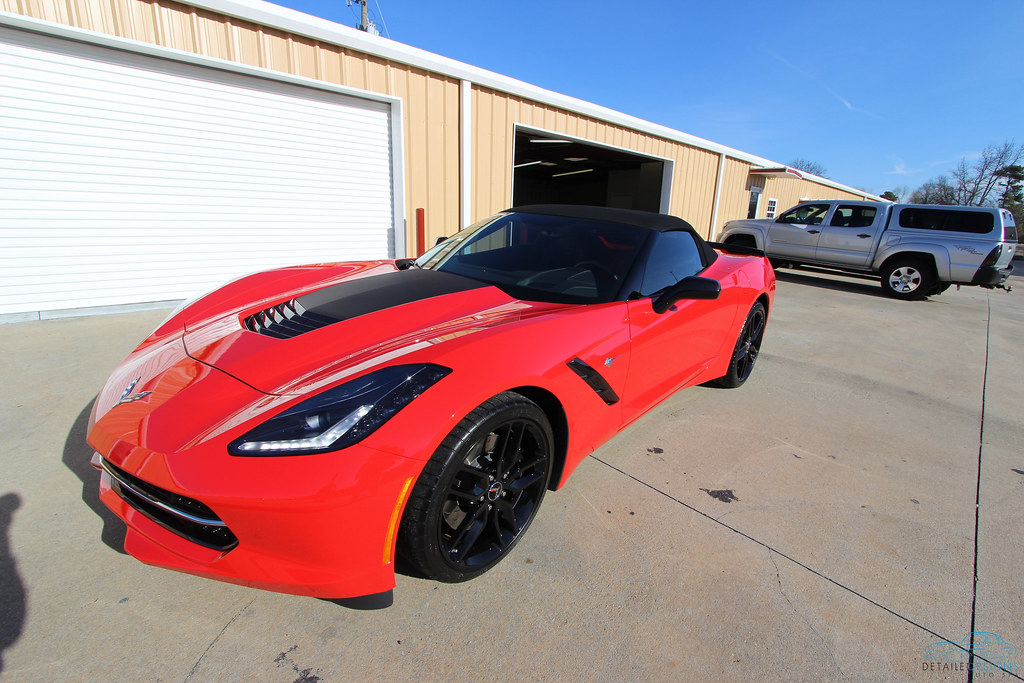
Thanks for taking the time to read about this project and learn about what we do at Detailed Designs Auto Spa. We work hard at bringing something special to the table for our clients in Atlanta and all the southeast and hope you can find value in some of the techniques we use in your own detail projects.
Related Posts
- 2014 Corvette Stingray Complete Detail with Clear Bra and Vinyl Wrap Install: Part 1 of 2
- Can I Use Products from Different Brands?
- Detailing Projects: Ferrari 488 Pista Paint Correction, Clear Bra, & Ceramic Coating
- Ford Maverick Hybrid XLT – New Car Detail
- Full Detail and Paint Correction: Ferrari 458 Italia by Todd Cooperider of Esoteric Auto Detail










Great work on the stingray, like how the hood looks now with the carbon vinyl.
Thanks Tony. The owner has had a lot of positive feedback about the carbon fiber vinyl stinger stripe.
What all products and steps were used to correct the paint
Big list of products for many different areas.
OMG, my dream car. Cant believe the delivered condition. Awesome job, if I could afford one it would look like that.
Thank you. I am strongly considering getting on the list for one.
Beautiful job. Im curious as to which pads and polish was used for the paint correction.
Hi Kevin,
We used purple foamed wool on the few very heavy defects(which is not typically included in our silver package but I could not bear to leave those very few heavy spots), orange and gray. I do not recall what products were used offhand.
Thanks for the kind words!!
What brand of clear bra was used on the vette?
Suntek’s self healing top coated film.
You took a new car and made it better-than-new…truly a dramatic improvement! But…I have to say that it seems like there is an awful lot of orange peel on this car, even after detailing. If I were the owner and were going to such lengths for this kind of detail, why not take care of that, too? I don’t mean to throw stones, and I feel “picky” bringing it up, but hey…this forum is for picky people who want to achieve the best possible finish. Thoughts?
Rob, I hear what you’re saying. But for some people, orange peel is a non-issue. It’s not my goal to make a mountain out of a client’s molehill. He requested that the car be shiny, protected, easy to maintain and to be within his budget. If orange peel was a concern of his, we certainly would have taken care of it.
Thanks for the feedback, Rob.
I get it…my perspective is of the owner, yours is of the business, and you are doing what the client asked (and is paying) for.
You said above you’re considering getting the new ‘vette… as an owner, would you remediate the orange peel? Inquring minds want to know!
Yes. I would make the paint look insane.
Amazing work! Would you use a sealer or anything after paint correction and before adding a clear bra? I know you said you used cQuartz on the exterior, but was that on the back half without the clear bra?
Hi Brandon. The CQuartz Finest was applied to the clear bra as well. It functions just the same. There is no need to put something between the clear bra and the paint though.
Thank you for your feedback!
You can definitely tell a difference when the clear bra is installed.
Hi Jean Claude
I asked a couple of questions in part one and hope you can answer them as well as the ones here.
When I look at this car and other “new” cars on this site it amazes me that coming from the factory they are in such bad condition, or is it that detailers are such perfectionists that nothing but perfection will do?
One would assume that it’s the factory /dealers responsibility to make sure a new car looks as good as this vet after you have worked on it?
That said can you explain why after a wrap you still use C-Quarts?
I am picking up a used Tesla that has a full Opticoat wrap and want to do everything in my power to make this car look its best for as long as possible (at least for the next 72 months payment schedule)
Are there different rules to applying C-Quarts over a wrap as opposed to directly to the paint, I have not found any tutorials addressing the above (hint).
Thanks
Steve
Hi Steve,
We have cars that we either pick up from the dealership and have not been touched by them as well as cars only washed once by a dealership and in both cases it’s more often than not that there are substantial defects.
There are fundamental problems on the factory and dealer level that tend to result in defects left or defects created before a client ever touches their new car. I could write a huge article on just the issues facing the new car purchaser.
For the boutique detailer/restoration expert, the situation is the same as many trades or crafts. Steve, you can liken how we are to probably how you are. Do you work with other people? What is their attitude when it comes to work? Are they finding excuses to slide poor quality work through without being seen? Are they cutting corners? Is their eye trained to look for the problems or just see the bit of good they’ve done? It’s the same for us. We are picky because it’s how we are. We can’t stand to see garbage work slide by just because we think the customer may not notice. Our eyes are tuned to find what’s wrong and fix it(depending on the agreement with the owner). No matter what trade this personality is associated with, they will act on their desire to exceed in their craft. You’re probably the same way and I can say that because you are here reading these articles. “Good enough” is probably not really good enough for you, right?
It just so happens we pay our bills by working on making cars beautiful and that’s how our personalities show through.
Great question about CQuartz after the ppf being applied.
In regards to protecting painted surfaces of automobiles, there is no better protection than ppf(paint protection film / clear bra). It is thicker and more resistant to all types of damage than the alternatives(such as coatings and wax). With that said, why do we install coatings on our paint? To make maintenance a breeze for many years and to add amazing protection. Putting a coating down under ppf is plain redundant. The benefits are lost as the ppf will protect the coating along with the paint. But by applying a coating over ppf, you are providing the same protections that it offers paint, to the ppf. So now, instead of being concerned with using the wrong wax over the ppf and causing yellowing or getting wax on the edges and building up…or damage from bug marks and bird droppings, your clear bra is substantially easier to maintain and better protected so it stays looking great for longer. PPF is not a maintenance-free product. It requires care and attention. The sacrificial layer of the coating on the ppf is not redundant. A coating on top of the ppf will ease maintenance requirements.
Some people like clear bra, some don’t. Some like coatings, some don’t. Some don’t like either. Some do like both. It’s understanding how they work individually as well as together that can bring added value to the owner. Understanding how they can work together also allows the owner to make an informed decision as to how much protection they care for VS what their budget will allow.
Excellent post Steve. Thanks for adding to the conversation.
The good Lord has blessed us with the new ‘vette! I see a beautiful black and white one every day and I envy the lady that drives it. I would do some bad things to own one of these. Great write up and beautiful work on the car!
Haha! And thanks Max!
Great job on the ‘vette! Amazing!
Mine is exactly like this one + red calipers. The paint job was really bad; I had to remove a few blemishes with a heavy polishing compound. I was thinking of color sanding it to reduce/eliminate the orange peal but then I red somewhere that the clear coat on these cars was too thin to do this safely. Sure enough, I found a spot on the edge of the hood where the red paint was so thin that carbon fiber showed through. This made me believe that what I red was probably true, which made me abandon the color sanding idea. After a polish and OptiCoat, it looks OK but far from perfect.
What is your take on this issue? Have you done clear coat thickness measurements on more than one Corvette? If so, what’s the variation from car to car? What would you consider a safe thickness?
Thank you Zlatko!
Too thin to wet sand? No in my humble opinion. If you play your cards right and you really wanted to reduce the orange peel without removing too much clear you could probably sneak by and remove 5-7 microns. I do not think you should do it without a PDG that can read composites though. Get too aggressive and you’ll wish you’d dropped $2k’ish on a good PDG.
Here is a reading of the paint on a brand new 2015 Stingray Z06 to show how common the readings are between this early 2014 Stingray and the latest/greatest Stingray. https://www.flickr.com/photos/autodetailingpros/16086972821/
The hood may be treated differently than other panels being carbon fiber. I can’t prove anything about the hood though. It’s crazy that you got through the clear and base coat and saw the cf weave. What paper and media were you using to sand?
I hope this helps you a bit.
Hi Jean Claude
Great post and really work too!
I have a tesla with PPF and CQuartz Finest on it. What’s the best way to keep the surface protected and cleaned? I have been quik detailing with CG products ECOSmart and Hybrid V07. Is that an overkill or worse, will it deteriorate the CQuartz?
veekay
Hi Veekay,
First off, excellent choice going with CQuartz Finest over clear bra!
My recommendation is to regularly wash with a multiple bucket wash method(with grit guards of course) and dry the surface as quickly as possible while keeping safety for the paint in mind(use forced air, sheeting https://www.youtube.com/watch?v=_CkwEEisFLE and/or high quality microfiber towels). At least once per year, treat the surface with Iron-X for decontamination. After each wash, I would treat the surface with Carpro Reload. Reload is cheap insurance for the coating as it does not cost much and only takes a few minutes to apply to a car’s exterior.
The products you are using will not cause the coating to deteriorate. CQuartz Finest is a coating that uses si02 as its active ingredient. si02 is chemically resistant and it would require gross neglect to cause failure of CQF.
It can’t hurt to schedule an appointment with your certified CQuartz Finest installer once per year as a means to perform the decontamination and a thorough detail. A certified CQuartz Finest installer is one of the most qualified detailers in the country and should have the ability to provide you with a quality service.
Thanks for the kind words and enjoy your amazing car and CQF!
-JC
I could use some of the work you did on this vette. Is it possible to get a cost breakdown for work done here??
Rudy,
If you’d like to call me, I am happy to provide you with our current pricing on any service( 678-859-1795 ). But be aware that detailing services are not commodities that can be easily priced head to head. With that said, my pricing may not mean a whole lot for you if you’re in a different area. I encourage you to read our article that outlines why it’s difficult to compare detailing services and their costs: https://www.detailedimage.com/Ask-a-Pro/why-is-there-such-a-great-disparity-in-detailing-service-pricing/
Car owners finding a qualified professional detailer in their area can be a journey. But, by taking the time to interview candidates, you can find someone that will provide you with an excellent value for your dollar.
-JC
Thanks for the “very fast” response as well as the info.
Will be in touch.